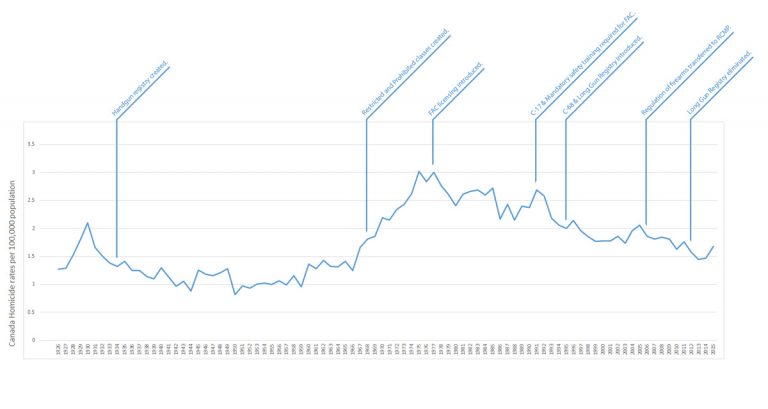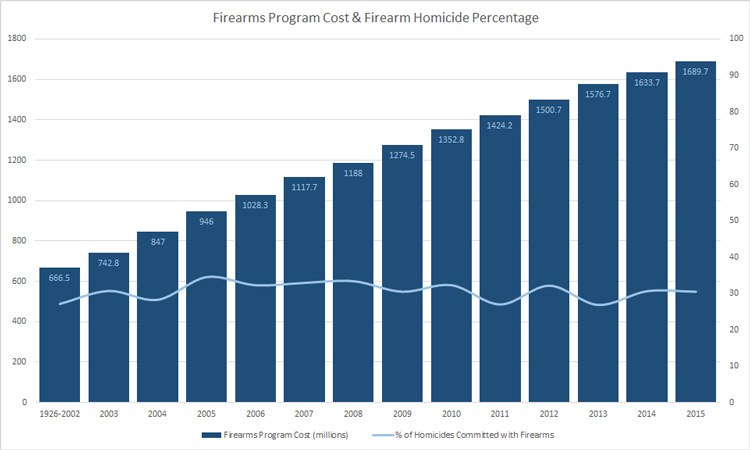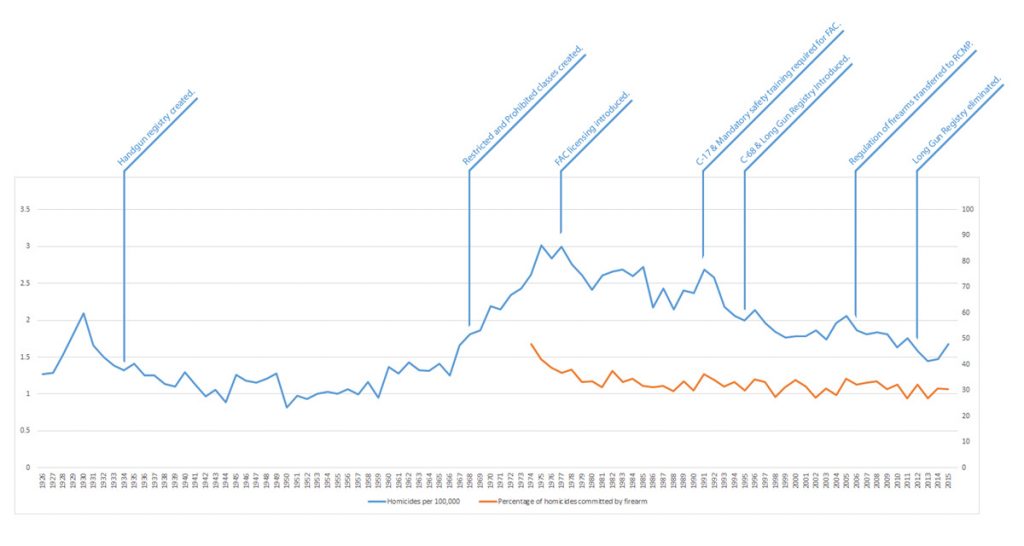
 Key Components
Key Components A History of Gun Control in Canada
A History of Gun Control in CanadaCanada, as many know, has a strict gun control regime. Involving licensing, mandatory safety training, justified ownership, registration of specific firearms, transit and storage laws, and extensive infrastructure surrounding the regulation of firearms, this system is convoluted, murky, and expensive. Operated by the RCMP under the title of the Canadian Firearms Program, this system costs Canadians an estimated $80 million per year; roughly equivalent to the cost incurred by the Supreme Court or the Canadian Senate.
But is that money actually making Canada any safer? To investigate, one must look back at both Canada’s extensive history with gun control, and the effectiveness it’s had on the overall rate of criminal homicide in this country. That examination begins in 1926; the first year of commonly available statistics on the matter.
In 1926, it may surprise many to know that Canada’s gun control system looked almost identical to that of today’s United States; citizens of “discretion and good character” could obtain a permit to carry a handgun in public while long arms of all varieties could be purchased by anyone. At the time, the homicide rate was a paltry 1.27 per 100,000.
In the years that followed, Canada’s murder rate remained largely unchanged, as did the firearms laws. Although 1934 brought with it the first proper handgun registry, carrying of a handgun for the purposes of self-defense, defense of property, or target shooting remained possible and the minimum age for firearm possession was lowered from 16 to just 12. In 1950 Canada’s murder rate dropped to an all-time low: 0.82 per 100,000.
In 1951, the long-running handgun registry was centralized, and fully automatic firearms that had remained entirely uncontrolled up this point were also required to be registered. Likewise, both handguns and machine guns were now required to have serial numbers, largely in order to facilitate their registration. However, no new or significant controls were placed on any firearms possession throughout the ‘50s, and Canadian gun owners continued to enjoy little to no constraints on things like machine gun possession and carrying a firearm for self-defense.
In 1969, the government moved towards changing that, categorizing guns as “restricted weapons” and “prohibited weapons” for the first time with bill C-151. This bill also allowed for any given firearm to be designated a restricted or prohibited firearm through an Order-In-Council, and brought forward the current registration system that requires a separate registration certificate for each firearm.
But the murder rate, which had been creeping upward throughout the tumultuous ‘60s, continued to climb; passing through 1.86 in 1969 to reach 2.19 in 1970. And as the ‘70s progressed, so too did the murder rate, eventually hitting an all-time high of 3.02 in 1975.
Just two years later, Bill C-51 was introduced; the first major piece of gun control legislation in Canadian history. Introducing formalized licenses in the form of Firearms Acquisition Certificates and introducing provincial Chief Firearms Officers, the bill also dramatically changed the criminal landscape, introducing new penalties, search and seizure powers, and new definitions of restricted and prohibited firearms. Furthermore, all fully automatic firearms were deemed prohibited, and carrying a personal firearm for the protection of property was no longer permitted for individuals. At the time, the murder rate was an even 3 murders per 100,000 individuals, with 36.8% of those murders being committed with a firearm.
In the years that followed, the murder rate would fluctuate, seemingly unaffected by this new gun control regime. Even more interestingly, the statistics surrounding the percentage of homicides committed with a firearm (a statistic that first became available in 1974) show almost no significant change, with 1978 actually showing an increase in the percentage of murders committed with a firearm. In fact, when the next large piece of gun control legislation was introduced in 1991, both the murder rate and percentage of murders committed with a firearm were shockingly similar to 1977’s numbers: 2.69 murders per 100,000, 36.2% of which were committed with a firearm.
The new legislation brought out in 1991, known as Bill C-17, built on the legacy of Bill C-51. With it came new restrictions on FAC issuance, mandatory safety testing for new applicants, a 28-day mandatory waiting periods for new licenses and a minimum of 2 character references for FAC applicants. But C-17’s largest target was the so-called “military-style” rifle. It reduced magazine capacities, and again revised restricted and prohibited definitions so as to deem various firearms such as Steyr AUGs and AK-pattern rifles prohibited, while also moving any firearm that had previously been converted from fully automatic to semi-automatic function from the non-restricted category to prohibited.
Obviously an incredibly large bill, C-17 wasn’t in force in its entirety until 1994, but was followed immediately by the largest and most comprehensive firearms control act in Canadian history: Bill C-68. Creating the Firearms Act, introducing the current PAL and RPAL system and ushering in the long gun registry, it also incorporated numerous firearms regulations; a series of controls passed through to law by committees without the need for legislative votes. As a result, C-68’s full impact wasn’t known until 1998, when the regulations were formalized and scheduled to be phased in on December 1, 1998. In 2006, the responsibility for the administration of the Firearms Act was passed from the Minister of Public Safety to the RCMP, and the Commissioner of the RCMP assumed the role of the Commissioner of Firearms.
And throughout all these sweeping changes, little to no change was detected when it came to the very thing these extensive and expensive laws were looking to address: The number of people killed by firearms. When C-17 was passed, the percentage of murders committed with a firearm was 36%. When the law came into force in 1994, 2% more murders were committed with firearms than the year before. Likewise, the years following the coming-into-force of Bill C-68, the Firearms Act, saw an increase from 1998’s then-record low rate of 27%, as the rate climbed to 34% by the year 2000.
Globally, most developed nations have seen similar decreases in violence and murder, through countless factors. Criminal rehabilitation to reduce recidivism, superior policing techniques, economic factors, and education all play a role and generally speaking, the rate of both murder and murder-by-firearm specifically throughout Canada’s history seems largely disconnected from the passage of gun laws. Examining a graph of Canada’s murder rate or even the percentage of murders committed with a firearm does not provide any obvious indication of years in which gun reform was passed. In fact, the most non-violent period in Canada’s past is undeniably those same decades in which guns were widely available and almost unchecked, and in which Canadians were permitted to carry firearms for protection.
However, whilst the effects of gun control are not readily apparent on the statistics recounting murder and gun homicide rates, the same cannot be said for Canada’s ledgers. Although the costs of earlier efforts such as 1934’s handgun registry are difficult to discern, the latest bout of gun control spanning from C-51 to today has been (relatively) well recorded…. Thanks in large part to a particularly damning Auditor General’s investigation into the Canadian Firearm’s Programs budget in 2006.
According to this report, and the ongoing annual budgets released by the RCMP and federal government, the Canadian Firearms Program amassed a cost of $666.5 million from its inception until the audit was completed in 2002. For each concurrent year, annual expenditures of between $60 and $100 million have been required to keep the program operational, leading to a cumulative total of $1.7 billion dollars in 2015.
To put that in perspective, the annual cost of operating a program that’s shown no demonstrable effect on gun violence carries an annual price tag that has, on average, cost roughly as much as Canada’s Senate or Supreme Court. That’s more money than the Canadian government earmarks for the auditor general, the tourism commission, the Senate, the Supreme Court, or the administration of the court system.
Furthermore, many questions raised by the Auditor General’s original report remain unanswered; such as the investigation into numerous payments of up to $310,000 with no cited deliverables tendered on the request for proposals, nor any deliverables shown to be received in exchange upon the supposed completion of the contract.
In fact, in the most recent years, the waters surrounding the Firearms Program’s cost have grown murkier, as the RCMP’s annual budgets have omitted the program’s explicit cost; instead preferring to roll the cost into the overall annual policing budget. Might we be headed towards yet another damning Auditor General report? Who knows.
References: Statistics Canada, RCMP Reports on Plans and Priorities, NFA ATIP request response, Auditor General, Government Expeditures.